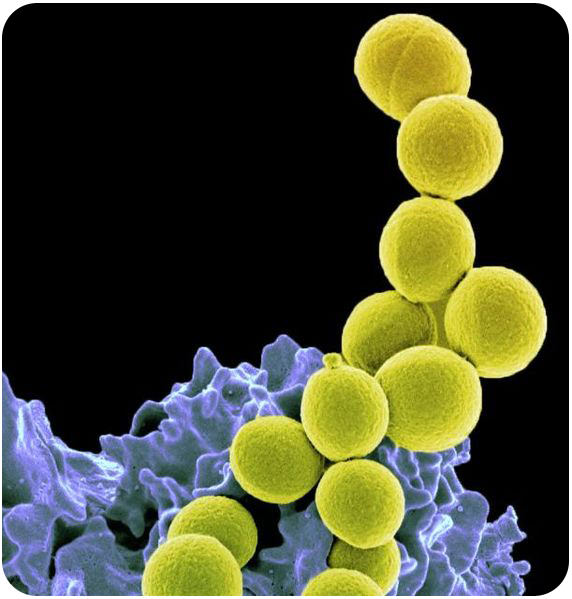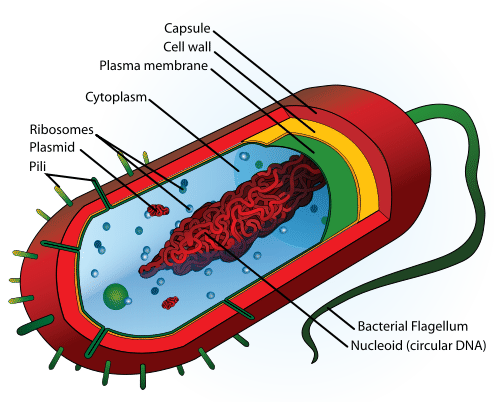5.2: Bacteria Characteristics
- Page ID
- 2941

Are bacteria living things?
Bacteria are individual living cells. Bacteria cells are similar to your cells in many ways; yet, they also have distinct differences. Bacteria have many unique adaptations allowing them to live in many different environments.
Characteristics of Bacteria
Bacteria are the most successful organisms on the planet. They lived on this planet for two billion years before the first eukaryotes and, during that time, evolved into millions of different species.
Size and Shape
Bacteria are so small that they can only be seen with a microscope. When viewed under the microscope, they have three distinct shapes (Figure below). Bacteria can be identified and classified by their shape:
- Bacilli are rod-shaped.
- Cocci are sphere-shaped.
- Spirilli are spiral-shaped.

Similarities to Eukaryotes
Like eukaryotic cells, bacterial cells have:
- Cytoplasm, the fluid inside the cell.
- A plasma or cell membrane, which acts as a barrier around the cell.
- Ribosomes, in which proteins are put together.
- DNA. By contrast though, bacterial DNA is contained in a large, circular strand. This single chromosome is located in a region of the cell called the nucleoid. The nucleoid is not an organelle, but a region within the cytoplasm. Many bacteria also have additional small rings of DNA known as plasmids.
The features of a bacterial cell are pictured below (Figure below).

Unique Features
Bacteria lack many of the structures that eukaryotic cells contain. For example, they don't have a nucleus. They also lack membrane-bound organelles, such as mitochondria or chloroplasts. The DNA of a bacterial cell is also different from a eukaryotic cell. Bacterial DNA is contained in one circular chromosome, located in the cytoplasm. Eukaryotes have several linear chromosomes. Bacteria also have two additional unique features: a cell wall and flagella. Some bacteria also have a capsule outside the cell wall.
The Cell Wall
Bacteria are surrounded by a cell wall consisting of peptidoglycan. This complex molecule consists of sugars and amino acids. The cell wall is important for protecting bacteria. The cell wall is so important that some antibiotics, such as penicillin, kill bacteria by preventing the cell wall from forming.
Some bacteria depend on a host organism for energy and nutrients. These bacteria are known as parasites. If the host starts attacking the parasitic bacteria, the bacteria release a layer of slime that surrounds the cell wall. This slime offers an extra layer of protection.
Flagella
Some bacteria also have tail-like structures called flagella (Figure below). Flagella help bacteria move. As the flagella rotate, they spin the bacteria and propel them forward. It is often said the flagella looks like a tiny whip, propelling the bacteria forward. Though some eukaryotic cells do have a flagella, a flagella in eukaryotes is rare.

Summary
- Bacteria can be classified by their shape, including bacilli (rods), cocci (spheres), and spirilli (spirals)
- Bacteria are like eukaryotic cells in that they have cytoplasm, ribosomes, and a plasma membrane.
- Features that distinguish a bacterial cell from a eukaryotic cell include the circular DNA of the nucleoid, the lack of membrane-bound organelles, the cell wall of peptidoglycan, and flagella.
Explore More
Use the resources below to answer the following questions.
Explore More I
- Prokaryotic Cells at http://www.youtube.com/watch?v=gGlhCWg5iOM (2:23)
- What does the word prokaryote mean?
- How does bacterial DNA differ from the DNA in eukaryotic cells? What is one explanation for this difference?
- What is the bacterial capsule? Are all bacterial capsules made of the same material?
- How does the movement of bacterial flagella differ from the movement of eukaryotic flagella?
Explore More II
- Cells Alive at http://www.cellsalive.com/cells/bactcell.htm
- Describe three features of a bacterial cell?
- What is the nucleoid?
- What is a plasmid?
Review
- How are bacteria classified?
- How are bacterial cells like your cells?
- How are bacterial cells different from your cells?
- Describe the bacterial flagella.

